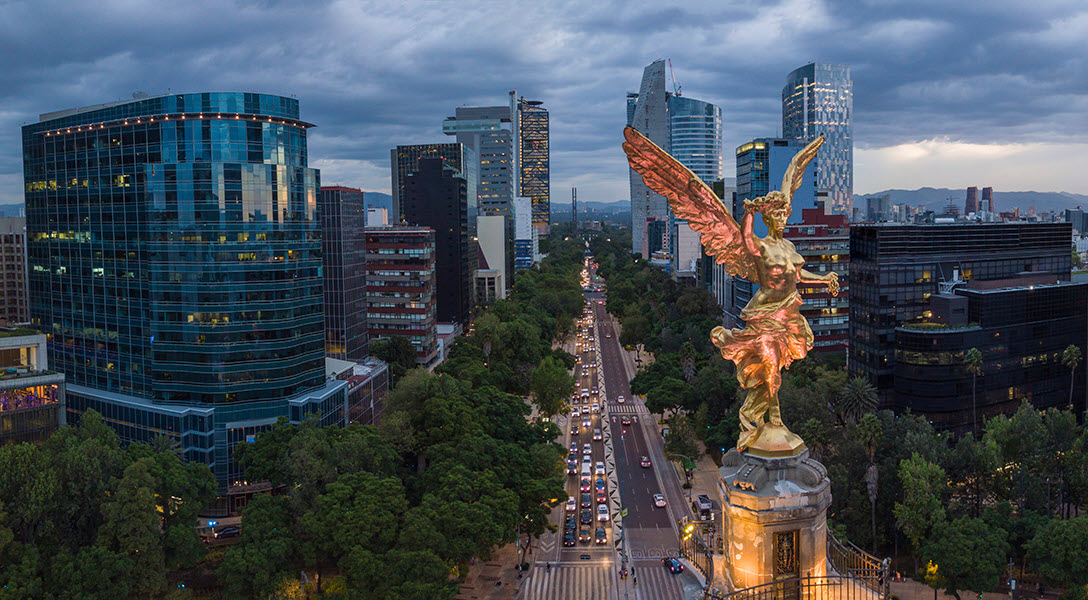
Mexico’s economic momentum continues; outlook improves
| October 2023 economic report | |||
| GDP, real Q2 '23 |
Employment, formal October '23 |
CPI October '23 |
Peso/dollar October '23 |
| 3.6% q/q | 18,000 jobs m/m | 4.3% y/y | 18.1 |
Mexico's economy expanded for an eighth consecutive quarter, driven by domestic consumption and industrial activity, according to the preliminary official estimate. Real GDP grew 3.6 percent in the third quarter, above the previous quarter’s gains of 3.4 percent and analyst expectations of 3.2 percent. The consensus forecast for 2023 GDP growth (fourth quarter, year over year) compiled by Banco de México rose to 2.7 percent in October (Table 1). Meanwhile, the average annual GDP growth forecast for 2023 rose from 3.2 percent in September to 3.3 percent in October.
| Table 1 Consensus forecasts for 2023 Mexico growth, inflation and exchange rate |
|||
| September | October | ||
| Real GDP growth in Q4, year over year | 2.4 | 2.7 | |
| Real GDP growth in 2023 | 3.2 | 3.3 | |
| CPI December 2023, year over year | 4.7 | 4.6 | |
| Peso/dollar exchange rate at end of year | 17.6 | 18.0 | |
| NOTE: CPI refers to the consumer price index. The survey period was Oct. 13–30.
SOURCE: Encuesta sobre las Expectativas de los Especialistas en Economía del Sector Privado: Octubre de 2023 (communiqué on economic expectations, Banco de México, October 2023). |
|||
The latest data available show industrial production, retail sales and employment increased while exports were flat. Inflation continued easing, and the peso retreated some against the dollar in October.
Output grows in third quarter
According to a preliminary estimate, Mexico’s third-quarter GDP rose an annualized 3.6 percent (Chart 1). On a nonannualized basis, the goods-producing sectors (manufacturing, construction, utilities and mining) grew 1.4 percent, up from the previous quarter’s growth of 0.8 percent. Activity in the services-providing sectors (wholesale and retail trade, transportation and business services) grew 0.6 percent, slower than the second quarter’s 1.0 percent increase. Agricultural output expanded 3.2 percent.
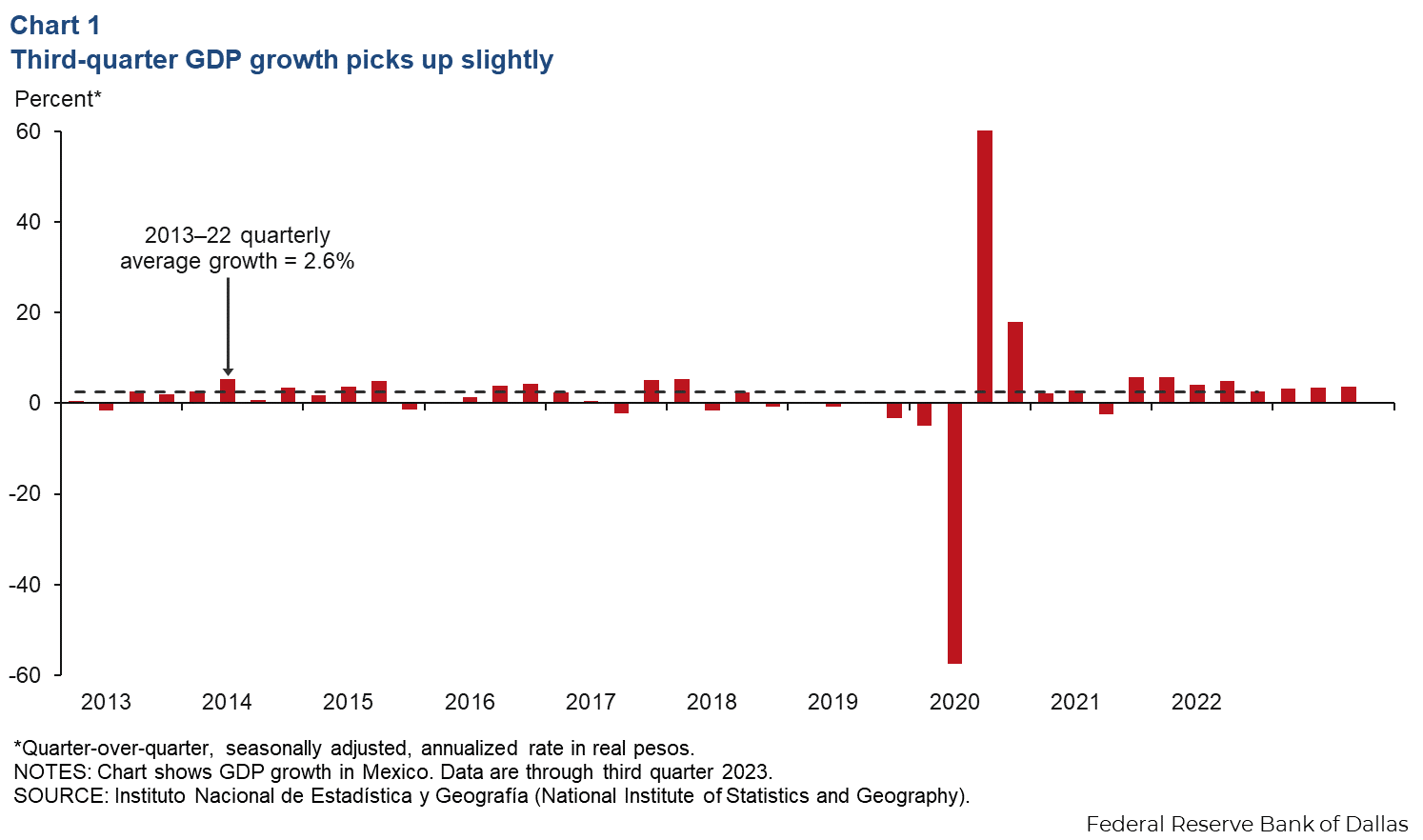
Industrial production picks up
The three-month moving average of Mexico’s industrial production (IP) index, which includes manufacturing, construction, oil and gas extraction, and utilities, grew 0.2 percent in September, while the smoothed manufacturing IP index rose 0.4 percent (Chart 2). North of the border, the smoothed U.S. IP index grew 0.4 percent in September after growing 0.2 percent in August. U.S. and Mexican IP have become more correlated with the rise of intra-industry trade between the two countries since the early 1990s. If U.S. consumer demand decelerates toward the end of the year in an environment of elevated inflation and higher credit costs, Mexico’s manufacturing sector could slow.
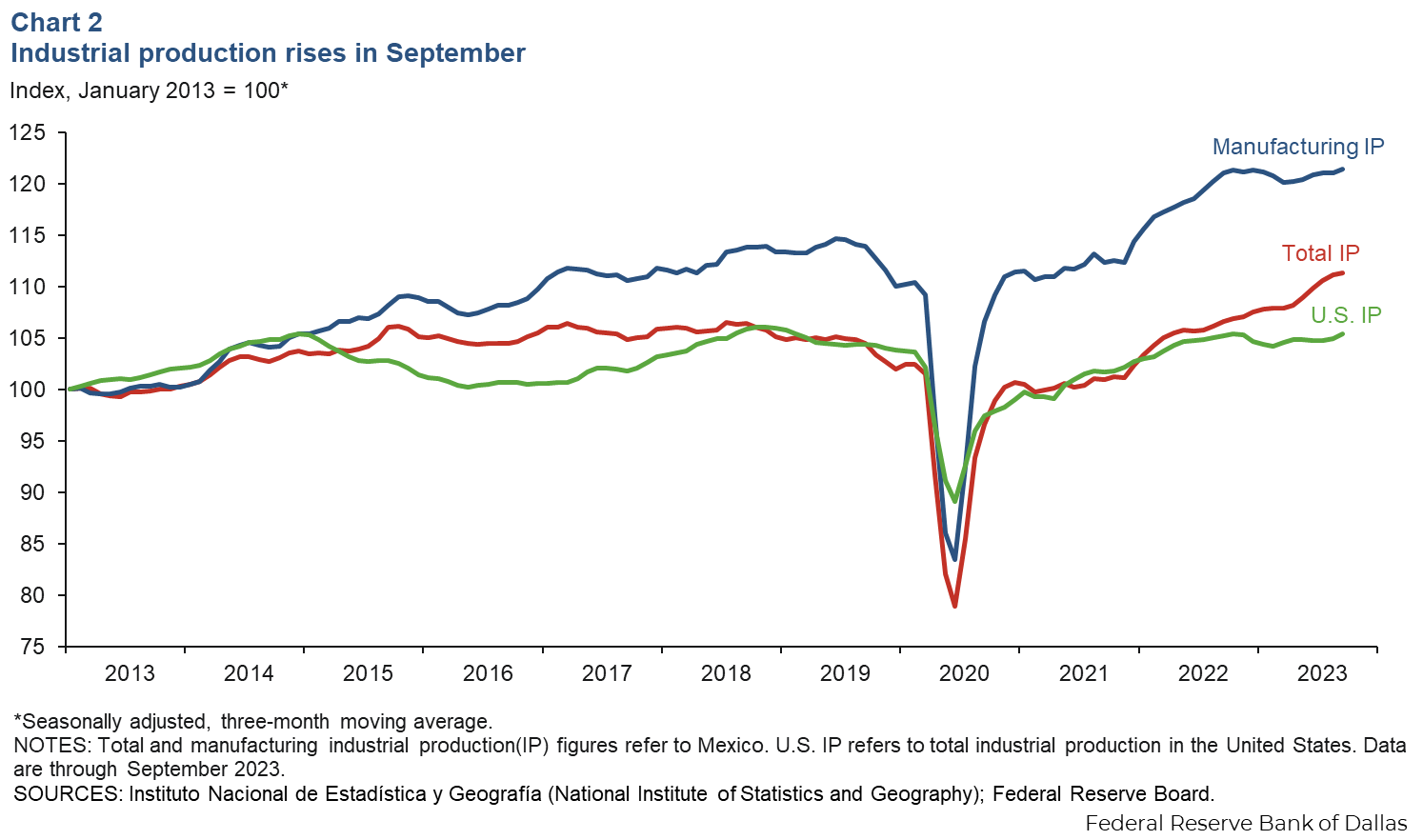
Exports little changed again in September
The three-month moving average of total Mexico exports was flat in September while oil exports grew 8.0 percent (Chart 3). The much larger manufacturing sector edged down 0.3 percent. Year-to-date total exports were down 1.3 percent compared with the same period in 2022, with manufacturing exports up 0.3 percent and oil exports falling 22.6 percent. The overall decline is likely due to slowing global demand.
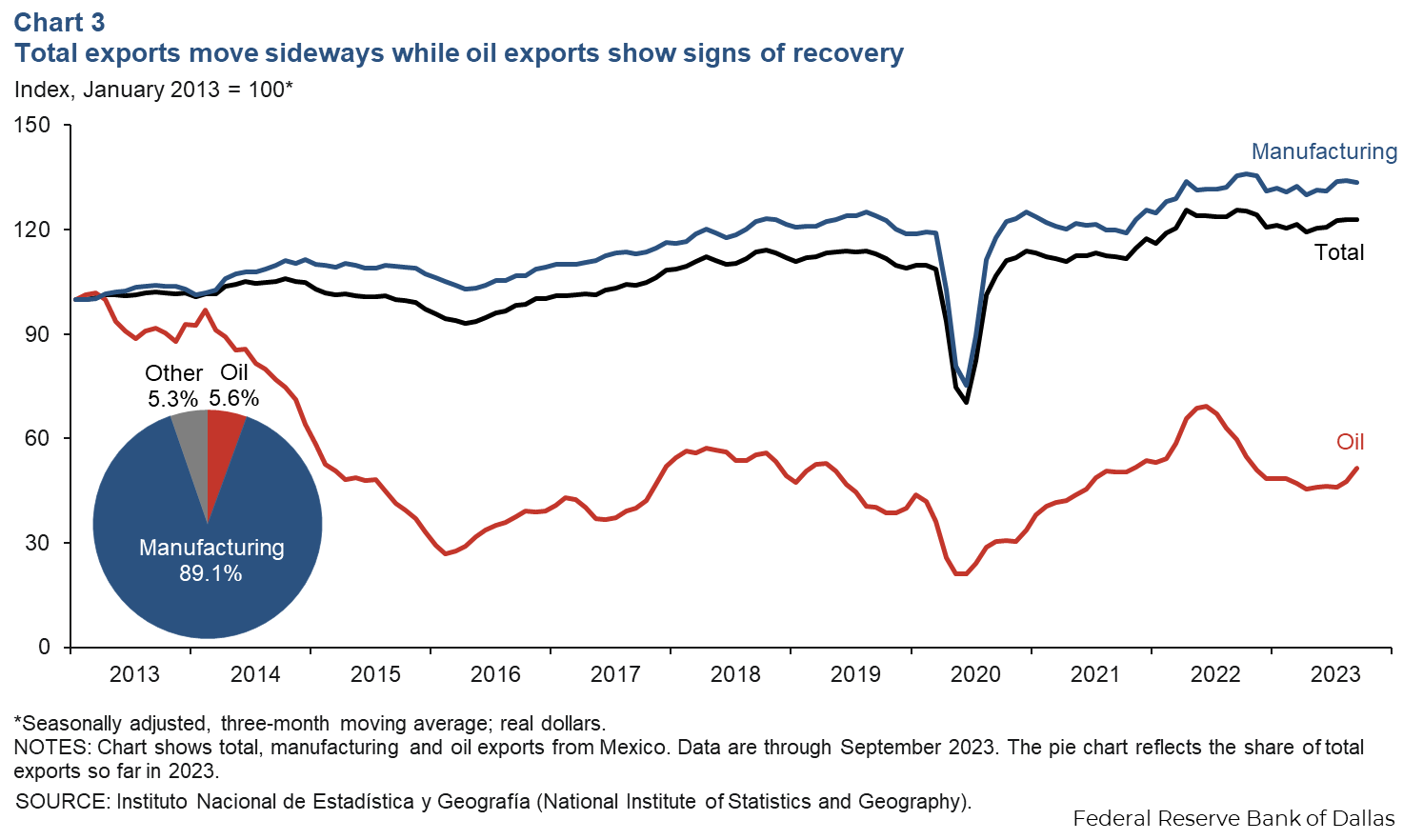
Retail sales continue to climb
The three-month moving average of real retail sales ticked up 0.6 percent in August, the latest data available (Chart 4). Year over year, the smoothed retail sales index was up 4.5 percent. Sustained growth in remittance flows may be contributing to the elevated level of Mexican retail spending despite high domestic inflation.
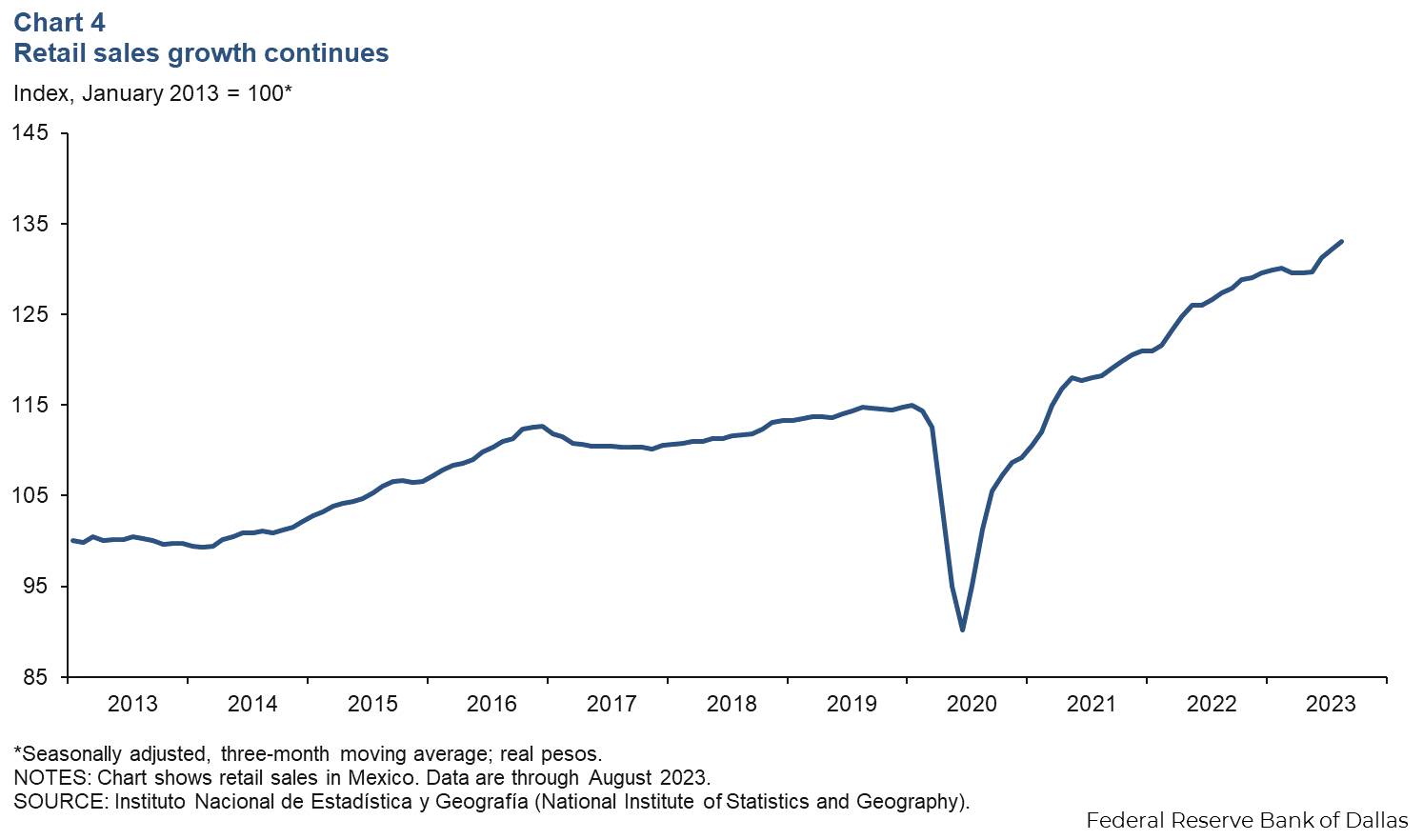
Job gains continue at sluggish pace in October
Formal sector employment—jobs with government benefits and pensions—only grew an annualized 1.0 percent (18,000 jobs) in October (Chart 5). Total employment, representing 58.5 million workers and including informal sector jobs, was up 1.9 percent year over year in second quarter 2023. The unemployment rate in September was 2.7 percent, the same as in August.
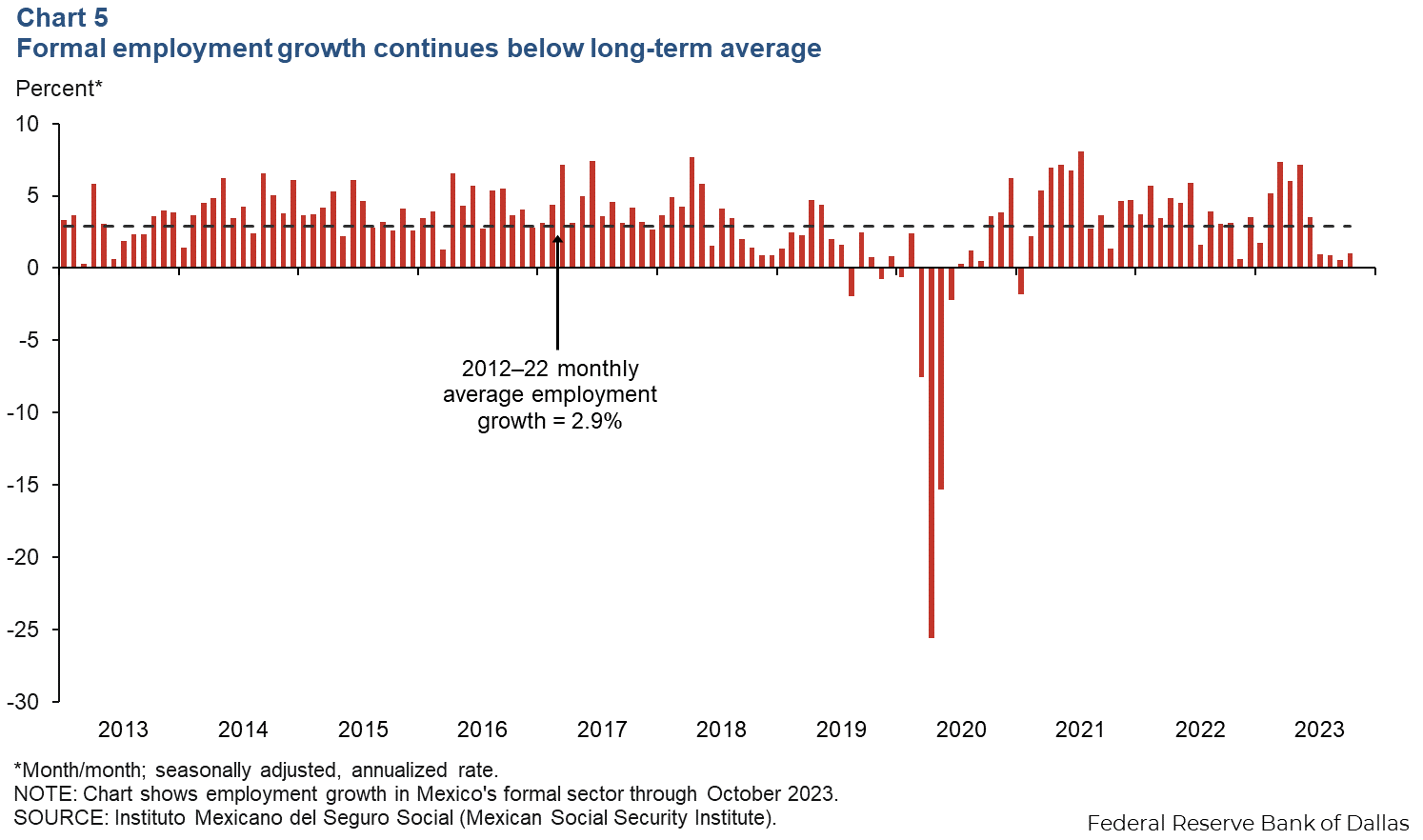
Peso ticks down in October
The Mexican currency averaged 18.1 pesos per dollar in October, below September’s average of 17.3 pesos per dollar (Chart 6). Mexico’s solid macroeconomic framework, fiscal discipline and prospects for nearshoring investment likely have contributed to the peso’s appreciation and stability this year despite some weakening in the last three months.
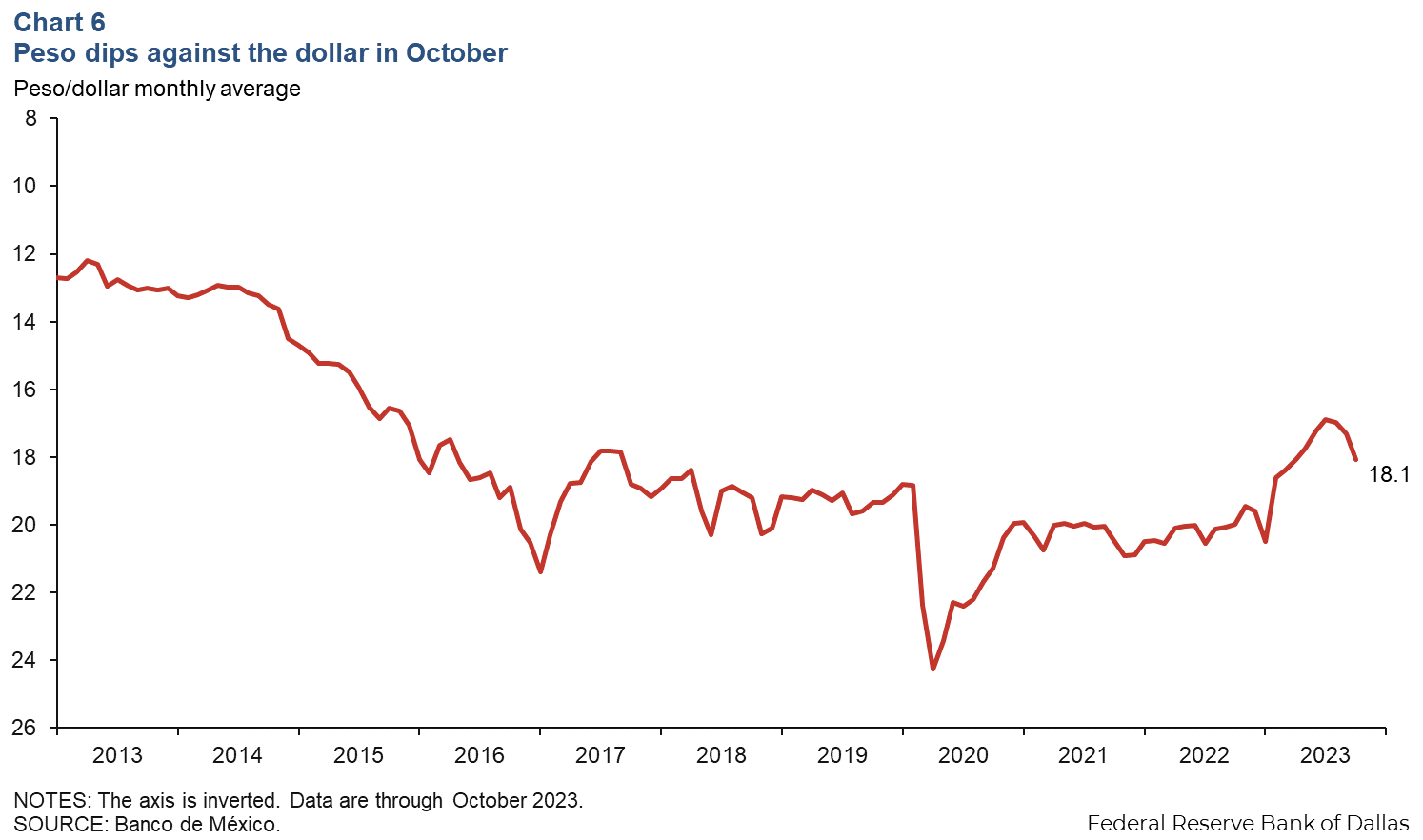
Remittances remain elevated
The three-month moving average of real remittances to Mexico grew 1.3 percent in September after being little changed in August (Chart 7). Remittances are close to record highs as U.S. job growth remains strong, boosting the capacity of Mexicans working abroad to send money back home.
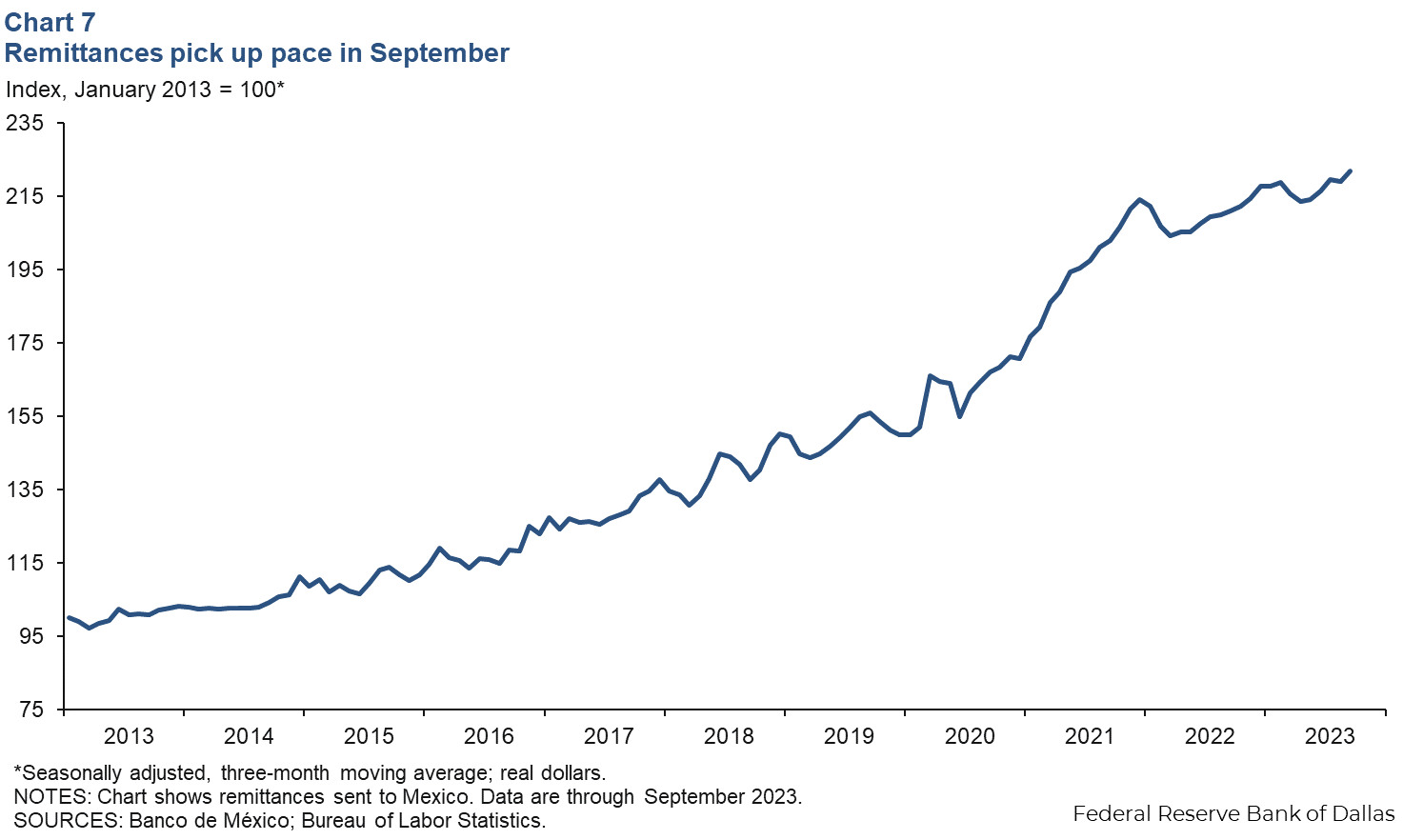
Domestic investment growth accelerates in 2023
Private investment has been on an upward trend since the end of the pandemic, reaching prepandemic levels in third quarter 2021. Private investment was 22.3 percent of GDP in second quarter 2023, up from 18.6 percent in first quarter 2020 (Chart 8). In addition, public investment is finally growing after years of decline, and it has stabilized at 2.5 percent of GDP. The increase in private investment is due to investment catching up after many projects were suspended due to the pandemic. A strong peso also makes imports of machinery and equipment less expensive, and companies are taking this opportunity to replace dated equipment. Finally, some of this domestic investment is in preparation for nearshoring projects, according to multiple sources.
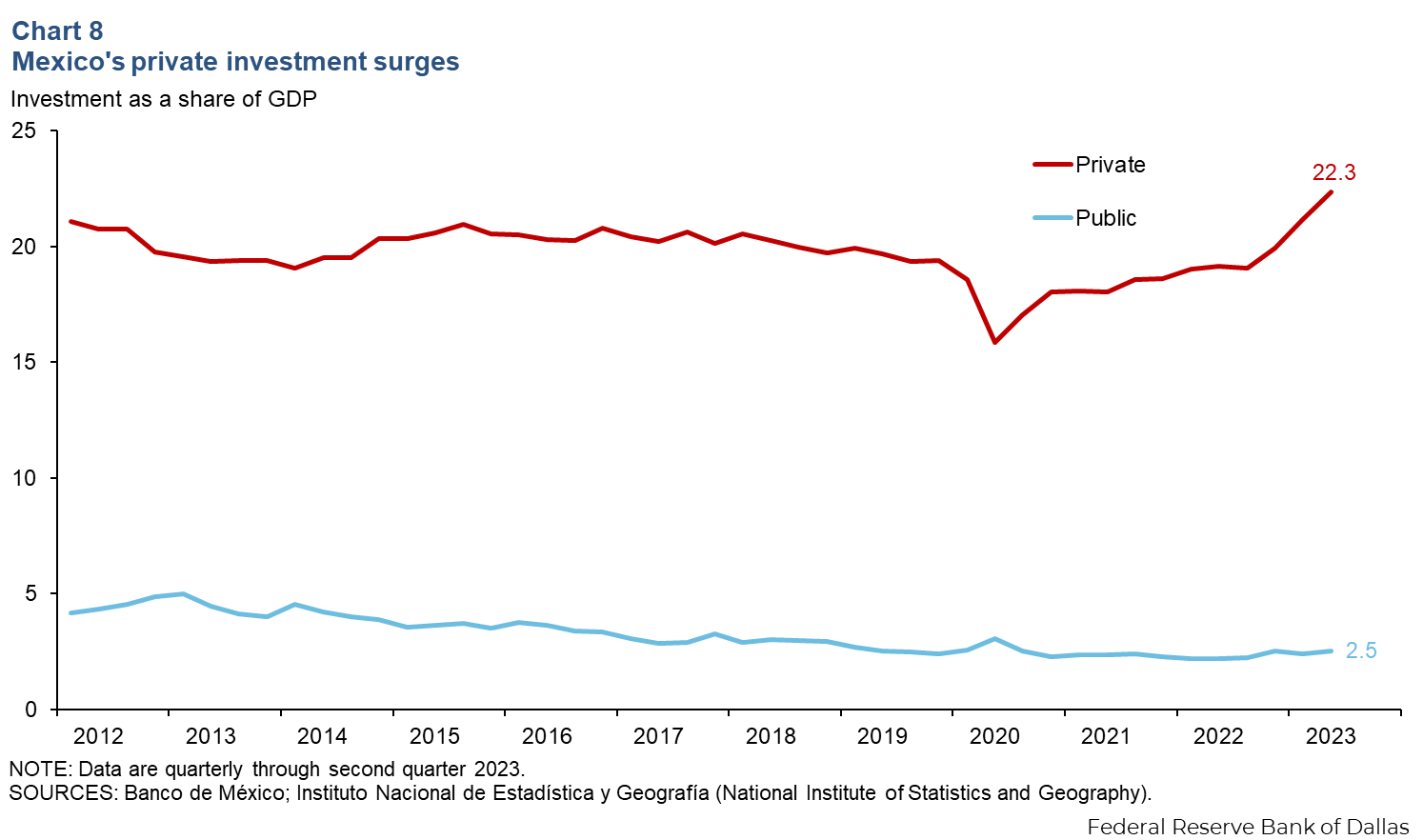
Inflation continues slowing
Mexico’s consumer price index (CPI) increased 4.3 percent in October, slightly slower than September’s 4.5 percent rise (Chart 9). CPI core inflation, which excludes food and energy, also slowed, to 5.5 percent. In November, Mexico’s central bank kept its benchmark interest rate steady at 11.25 percent for the fifth consecutive meeting. The central bank noted in a statement that although the inflation outlook remains complicated, progress has been made. However, the central bank noted still-elevated core inflation as one of the main risks to the outlook. The central bank expects inflation to converge to the 3.0 percent target by second quarter 2025.
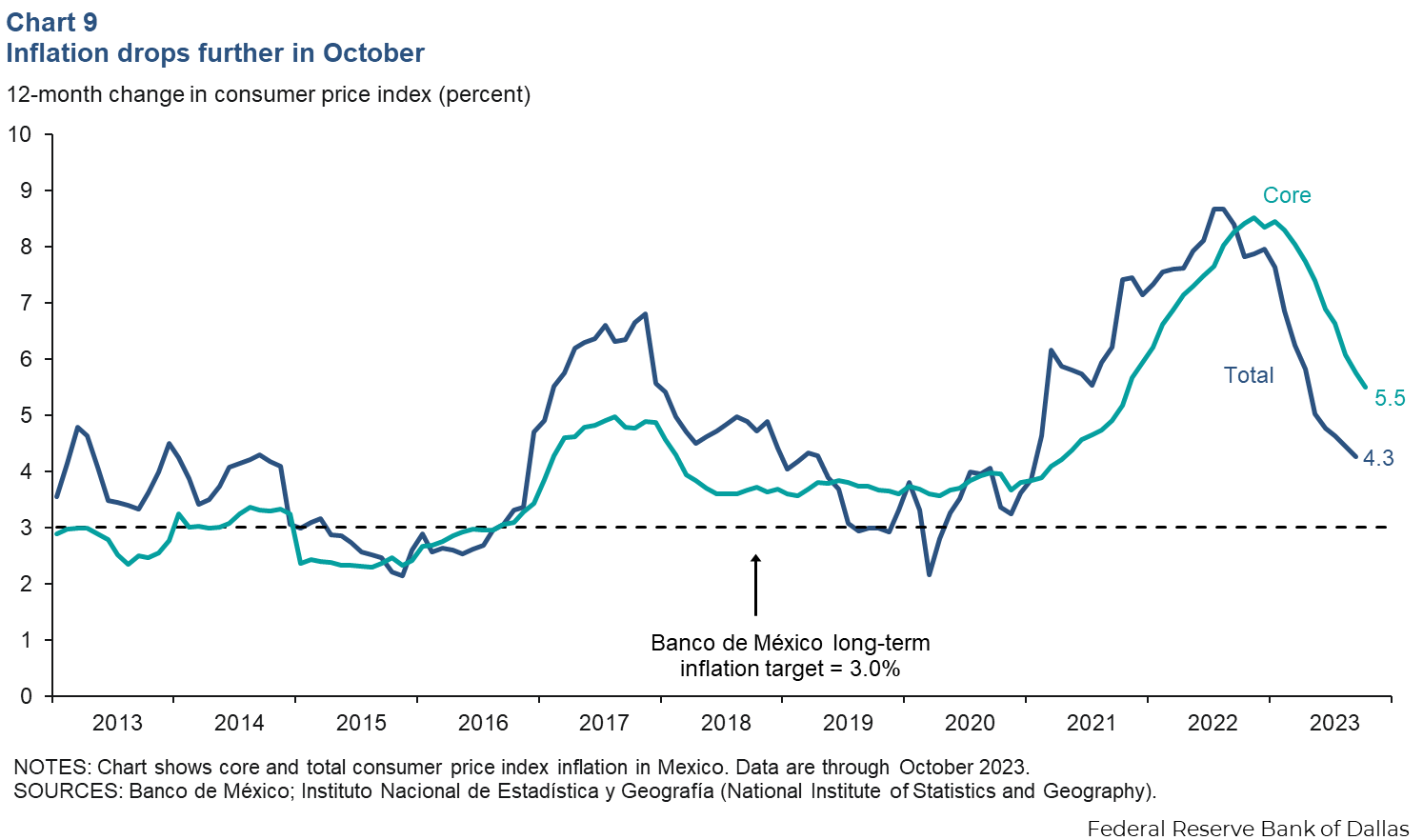
About the authors

